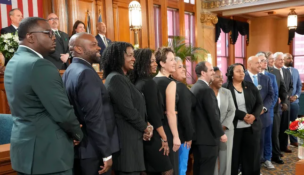10 Commandments Case Analysis
By: dmc-admin//July 6, 2005//
The decision completely changes the law in the Seventh Circuit, where longstanding monuments have been held unconstitutional, and recent public displays upheld.
The governing law in the circuit comes from long-running litigation involving Elkhart County, Indiana.
As in Texas, the Fraternal Order of Eagles donated a granite monument to the county in 1958. Among the participants at the dedication was a rabbi, a priest, and a minister, and the text is an amalgamation of Jewish, Protestant and Catholic versions of the Ten Commandments. Both the Star of David and a symbol representing Christ — two Greek letters, Chi and Rho superimposed — are on the monument. Also, a number of other nonreligious monuments are on the property.
In the 1990s, two Elkhart County residents brought suit in Indiana federal court to have the monument removed. The Seventh Circuit held the monuments violated the Establishment Clause. Books v. City of Elkhart, Indiana, 235 F.3d 292 (7th Cir. 2000)(Books I).
Elkhart County responded by setting up a display in the county administration building. The display consisted of the King James Version of the Ten Commandments, and all the same other texts as in the Kentucky cases, except that it substituted the Preamble to the Indiana Constitution for that of Kentucky’s. The exhibit even had the same name: “Foundations of American Law and Government Display.”
William A. Books, one of the two plaintiffs in the monument suit, again sued. In this case, however, the Seventh Circuit held the display constitutional. Books v. Elkhart County, Indiana, 401 F.3d 857 (7th Cir. 2005)(Books II).
The court found that the county’s stated purposes in erecting the displays was secular — to educate its citizens in the history of American law and politics and provide moral uplift.
The court wrote, “The inclusion of the Ten Commandments in a multifaceted historical exhibit of texts and images that have influenced or symbolized American law and government cannot reasonably be understood as an endorsement of religion.” Books II, at 858.
In light of the Supreme Court decision in Van Orden, it is clear that Books I is no longer valid law. In both monument cases, the monuments were erected decades ago, and no one objected until recently.
In both cases, the text is an amalgamation of the Ten Commandments — Protestant, Catholic, and Jewish — and the monument is one of many on the public grounds. No reasonable basis exists for distinguishing the monument in Elkhart County from that on the Texas capitol.
Books II is also probably no longer valid law.
The displays are identical, right down to the name of the exhibit. Both use the King James Version of the Commandments, rather than the Judeo-Christian amalgamation. Also, both are of recent origin, and were controversial.
Thus, the only basis for distinguishing Books II from McCreary is if there is a significant difference in the local history leading up to the two exhibits; the majority opinion in McCreary placed great emphasis on the individual local history leading to erection of the displays. In Elkhart County, the history is necessarily different.
Nevertheless, it seems unlikely that any difference would be enough to overcome the obvious similarities.
Since the decisions were released last week, they have been derided as being “confusing,” and “an invitation to more litigation.”
In fact, however, there is a sound basis for why the monument is acceptable, and the courthouse displays are not, and it is the intent of those who erected them.
From all available evidence, it seems indisputable that the Ten Commandments monuments erected in the 1950s throughout the country were erected with the best of intent in a spirit of genuine good will.
One can easily imagine the local citizenry remarking on how nice it was that the local minister, the local priest, and the local rabbi were all be present and all could agree on acceptable language for the second commandment (a source of vehement disagreement).
To use modern parlance, they were being as inclusive as they knew how to be back then (certainly, there were atheists and members of religions that do not recognize the Ten Commandments in Texas and in Elkhart County, but nothing suggests that ill will towards had any role in the monuments).
The same cannot be said of the displays erected around the country in the late 1990s. The counties involved have been around a long time; if it were really so important to have a display of important texts that included the Ten Commandments, then why did the governments involved not do so long ago, instead of waiting until the Ten Commandments had become the issue de jour in the culture wars?
| |
||
|
Related Links Related Article |
||
| |
||
To distinguish between the 1950s monuments and the late 1990s Foundation displays on this basis is not unprincipled, or confusing.
The rule can be applied in future cases: the old monuments are constitutional; those erected while the Ten Commandments were the issue de jour in the culture war will be presumed to be salvos in that war, but that presumption will be rebuttable based on local history.
Such a rule promotes government neutrality, which neither of the lead dissents would.
The question is whether Breyer’s concurrence allows or forbids any future displays or monuments. The answer would seem to be, “not now, but maybe in the future.”
Today, the Ten Commandments are a battleground on which people have chosen to fight a cultural war. With time, they will likely grow bored with it, and find a new issue de jour. Once they do, it may again be possible for people of genuine good will to display the Ten Commandments in a non-divisive way.
– David Ziemer
Click here for Main Story.
David Ziemer can be reached by email.
Legal News
- Milwaukee’s Common Council now has the most African Americans, women and openly LGBTQ members ever
- Office of School Safety Provides Behavioral and Threat Assessment Management Training Ahead of 25th Anniversary of Columbine Shooting
- Wisconsin Supreme Court to hear arguments in Democratic governor’s suit against GOP-led Legislature
- Lawsuit asks Wisconsin Supreme Court to strike down governor’s 400-year veto
- Wisconsin man pleads not guilty to neglect in disappearance of boy
- ACS Selects University of Wisconsin Law School’s Miriam Seifter for 2024 Ruth Bader Ginsburg Scholar Award
- People with disabilities sue in Wisconsin over lack of electronic absentee ballots
- Wisconsin Republicans ignore governor’s call to spend $125M to combat ‘forever chemicals’
- Native American voices are finally factoring into energy projects
- Steven Avery prosecutor Ken Kratz admits ‘mistakes were made’
- Colombian national extradited to Milwaukee faces International narcotics-trafficking conspiracy charge
- MPD: Milwaukee homicides down nearly 40 percent compared to last year
WLJ People
- Power 30 Personal Injury Attorneys – Russell Nicolet
- Power 30 Personal Injury Attorneys – Benjamin Nicolet
- Power 30 Personal Injury Attorneys – Dustin T. Woehl
- Power 30 Personal Injury Attorneys – Katherine Metzger
- Power 30 Personal Injury Attorneys – Joseph Ryan
- Power 30 Personal Injury Attorneys – James M. Ryan
- Power 30 Personal Injury Attorneys – Dana Wachs
- Power 30 Personal Injury Attorneys – Mark L. Thomsen
- Power 30 Personal Injury Attorneys – Matthew Lein
- Power 30 Personal Injury Attorneys – Jeffrey A. Pitman
- Power 30 Personal Injury Attorneys – William Pemberton
- Power 30 Personal Injury Attorneys – Howard S. Sicula











